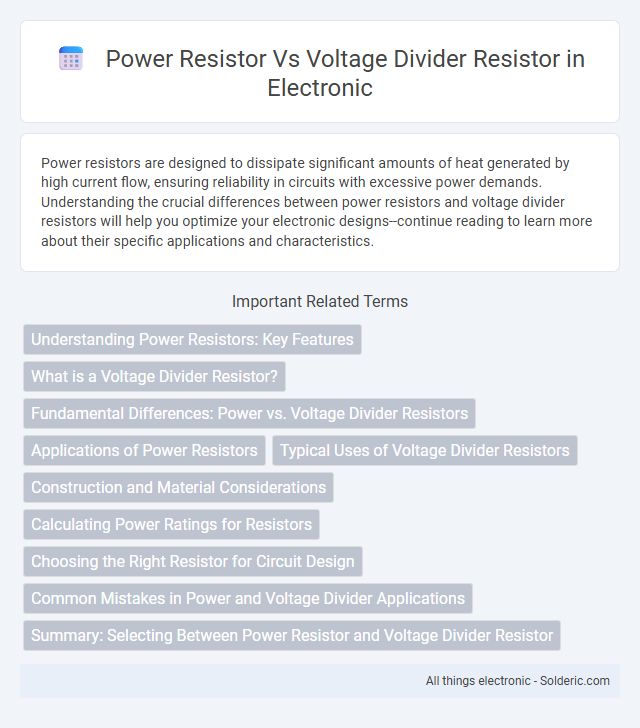Power resistors are designed to dissipate significant amounts of heat generated by high current flow, ensuring reliability in circuits with excessive power demands. Understanding the crucial differences between power resistors and voltage divider resistors will help you optimize your electronic designs--continue reading to learn more about their specific applications and characteristics.
Comparison Table
| Feature | Power Resistor | Voltage Divider Resistor |
|---|---|---|
| Primary Function | Dissipates electrical power as heat | Divides voltage into smaller levels |
| Power Rating | High (typically 1W to 100W+) | Usually Low to Moderate (0.25W to 2W) |
| Resistance Value | Typically Low to Medium (Ohms to kilo-ohms) | Range varies to set specific voltage ratio |
| Heat Dissipation | Designed to handle significant heat | Limited heat due to lower power |
| Application | Load testing, current regulation, power electronics | Signal conditioning, voltage scaling, sensor interfacing |
| Construction | Heat-resistant materials, larger size | Standard resistor components |
| Cost | Higher due to specialized build | Lower |
| Example Use Case | Motor driver current limiter | Voltage measurement scaling |
Understanding Power Resistors: Key Features
Power resistors are designed to dissipate high amounts of electrical power, often exceeding several watts, which makes their thermal management crucial for reliable operation. They feature robust construction with materials such as metal oxide or wire wound elements that provide stability under high temperatures and current loads. Unlike voltage divider resistors, power resistors are optimized for handling significant heat dissipation rather than precise voltage division, ensuring durability in high-power applications.
What is a Voltage Divider Resistor?
A voltage divider resistor is a component used in an electrical circuit to create a specific output voltage that is a fraction of its input voltage by distributing voltage across two or more resistors connected in series. Unlike power resistors, which are designed to dissipate significant amounts of electrical power as heat, voltage divider resistors primarily focus on achieving precise voltage levels for sensor inputs, signal conditioning, or reference voltages. The effectiveness of a voltage divider resistor in producing stable voltage depends on the resistor values and their tolerance, ensuring accurate voltage scaling in analog and digital electronics.
Fundamental Differences: Power vs. Voltage Divider Resistors
Power resistors are designed to handle high wattage and dissipate significant heat without damage, making them essential for applications requiring energy dissipation and current limiting. Voltage divider resistors, typically lower power ratings, are configured in series to proportionally split voltage across components, focusing on precise voltage reduction and signal conditioning. The fundamental difference lies in the power handling capacity and primary function: power resistors manage energy dissipation, while voltage divider resistors emphasize voltage division accuracy.
Applications of Power Resistors
Power resistors are essential in applications requiring the dissipation of large amounts of electrical energy, such as in motor controls, power supplies, and load testing where heat management is critical. Unlike standard voltage divider resistors used mainly for signal scaling or biasing in low-power circuits, power resistors handle higher current and voltage loads while maintaining stability and reliability. Your choice of power resistor ensures efficient energy conversion and protection in high-power electronics, making them indispensable in industrial and automotive systems.
Typical Uses of Voltage Divider Resistors
Voltage divider resistors are commonly used in sensor signal conditioning to scale down voltage levels for analog-to-digital converters (ADCs) in microcontroller circuits. They are essential in reference voltage generation and biasing transistors or operational amplifiers in electronic devices. Typical applications also include adjusting signal levels in audio equipment and creating reference points within measurement systems.
Construction and Material Considerations
Power resistors are designed with robust construction using materials like thick film, wire-wound, or metal oxide to withstand high power dissipation and heat. Voltage divider resistors typically use standard carbon film or metal film materials optimized for precise resistance values and minimal noise rather than power handling. Your choice depends on the application's power requirements and stability needs, with power resistors aimed at durability and voltage divider resistors focused on electrical accuracy.
Calculating Power Ratings for Resistors
Calculating power ratings for resistors requires understanding their dissipation capacity under voltage and current conditions. Power resistors are designed to handle higher wattage, often specified in watts (W), making them suitable for high-power applications where heat dissipation is critical. Voltage divider resistors typically carry lower power loads, so calculating their power rating involves multiplying the voltage drop across the resistor by the current flowing through it to ensure they operate within safe thermal limits.
Choosing the Right Resistor for Circuit Design
Choosing the right resistor for circuit design depends on power dissipation and voltage handling requirements. Power resistors are designed to handle higher wattages and dissipate more heat, making them suitable for applications with significant current or power load. Voltage divider resistors focus on precise resistance values to achieve desired voltage levels in circuits, so selecting them requires considering tolerance and stability to maintain voltage accuracy for your projects.
Common Mistakes in Power and Voltage Divider Applications
Using a voltage divider resistor for high power dissipation without considering its power rating can lead to resistor failure and circuit malfunction. Power resistors must be chosen based on accurate thermal management calculations to prevent overheating, while common mistakes include neglecting voltage and current limits in voltage divider designs. Your circuit's stability improves when resistors are appropriately rated and correctly positioned to avoid signal distortion or voltage inaccuracies.
Summary: Selecting Between Power Resistor and Voltage Divider Resistor
Choosing between a power resistor and a voltage divider resistor depends on your circuit's power dissipation and voltage regulation needs. Power resistors handle higher wattage and thermal loads, making them ideal for managing significant current and heat. Voltage divider resistors primarily provide precise voltage reduction with lower power ratings, suitable for signal-level applications where You need stable voltage outputs.
Power resistor vs voltage divider resistor Infographic

 solderic.com
solderic.com